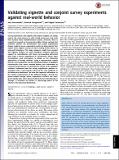Validating vignette and conjoint survey experiments against real-world behavior
Author(s)
Hainmueller, Jens; Hangartner, Dominik; Yamamoto, Teppei
DownloadHainmueller-2015-Validating Vignette.pdf (718.1Kb)
PUBLISHER_POLICY
Publisher Policy
Article is made available in accordance with the publisher's policy and may be subject to US copyright law. Please refer to the publisher's site for terms of use.
Terms of use
Metadata
Show full item recordAbstract
Survey experiments, like vignette and conjoint analyses, are widely used in the social sciences to elicit stated preferences and study how humans make multidimensional choices. However, there is a paucity of research on the external validity of these methods that examines whether the determinants that explain hypothetical choices made by survey respondents match the determinants that explain what subjects actually do when making similar choices in real-world situations. This study compares results from conjoint and vignette analyses on which immigrant attributes generate support for naturalization with closely corresponding behavioral data from a natural experiment in Switzerland, where some municipalities used referendums to decide on the citizenship applications of foreign residents. Using a representative sample from the same population and the official descriptions of applicant characteristics that voters received before each referendum as a behavioral benchmark, we find that the effects of the applicant attributes estimated from the survey experiments perform remarkably well in recovering the effects of the same attributes in the behavioral benchmark. We also find important differences in the relative performances of the different designs. Overall, the paired conjoint design, where respondents evaluate two immigrants side by side, comes closest to the behavioral benchmark; on average, its estimates are within 2% percentage points of the effects in the behavioral benchmark.
Date issued
2015-02Department
Massachusetts Institute of Technology. Department of Political ScienceJournal
Proceedings of the National Academy of Sciences
Publisher
National Academy of Sciences (U.S.)
Citation
Hainmueller, Jens, Dominik Hangartner, and Teppei Yamamoto. “Validating Vignette and Conjoint Survey Experiments Against Real-World Behavior.” Proc Natl Acad Sci USA 112, no. 8 (February 2, 2015): 2395–2400.
Version: Final published version
ISSN
0027-8424
1091-6490